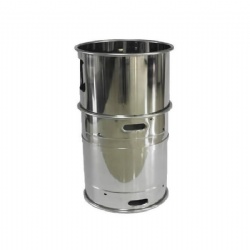Home > 1,3-Propane Sultone(1,3-PS)
1,3-Propane Sultone(1,3-PS)
1,3-Propane sultone
Synonyms:1,3-PS; 1,3-propanesultone; 1,2-oxathiolane 2,2-dioxide
CAS No.:1120-71-4
EINECS No.:214-317-9
Molecular Formula:C3H6O3S
Molecular Weight:122.143
Structure Formula:

Standard:
|
Grade Items |
Battery Grade |
Pharm Grade |
Electroplating Grade |
|
Appearance |
Colorless or yellowish transparent liquid or needle-like crystals |
Yellowish brown transparent liquid or crystals |
Yellowish brown transparent liquid or crystals |
|
Color(APHA) |
≤30 |
≤100 |
≤100 |
|
Purity(GC) |
≥99.9% |
≥99.5% |
≥99.0% |
|
Water(Karl-Fischer) |
≤100ppm |
≤1000ppm |
≤1000ppm |
Properties:It is a colorless or yellowish brown transparent liquid, crystallized at low temperature. Melting point: 30-33℃, Boiling point: 180℃ (30 mmHg), Density (25℃) : 1.392g/ml, Refractive index (25℃) : 1.4585: Flash point: 110℃. Soluble in ethanol, acetone, slightly soluble in water.
Uses:1,3-Propanesultone is an excellent sulfonating agent. It can react with many kinds of compounds under very mild conditions, accurately providing sulfonic acid groups, thus endowing these compounds with new properties (such as hydrophilicity, antistatic properties, etc.). It is widely used in pharmaceutical and chemical industry, photosensitive materials, lithium batteries, biochemistry, textile, lubrication, wastewater treatment, surface treatment and other industries.
1. It can be widely used in electroplating industry as the starting material for synthesis of electroplating intermediates, because its derivatives can improve the surface properties of substances. For example, it is used to synthesize PPS, UPS, DPS, MPS, ZPS, POPS, SP and other plating additive intermediates.
2. As an electrolyte additive for lithium-ion power battery. It can reduce the embedding of lithium battery solvent into the electrode, prolong the life of the electrode, improve the power cycle efficiency, increase the number of lithium battery cycles, and improve the service time of lithium batteries.
3. It is used in the synthesis of leather, ink and hate infection material, and can also be used as a brightener.
4. It is an important synthetic raw material of cationic or amphoteric ionic surfactants, which can be used as printing and dyeing finishing agents. The cationic coloring of cotton fiber is greatly improved after it is treated.
5. Used as antibacterial synergist, combined with sulfonamides to enhance antibacterial effect, also used in avian coccidia infection, intestinal bacterial infection and drinking agent.
6. It can also be used in the synthesis of polycarbonate fireproof agent, lubricating grease thickener, polypropylene antistatic agent, polyethylene imine crosslinking agent, etc.
Storage:Store in a cool, ventilated and dry place. Keep away from heat and fire sources. Avoid direct light irradiation. Don’t contact with oxides, reducing agents, acids and bases. The shelf life is 6 months below 25°C.
Packing:20kg or 200kg stainless steel drums with quick joints and filled with nitrogen (nitrogen pressure 0.11-0.13mpa). Samples can be packed in aluminum bottles with vacuumed aluminum foil bags.
Products Category
Latest News
Contact Us
Tel: +86-561-3306168 / 3308168
Fax: +86-561-3308168
Mobile: 13905616951
E-mail: [email protected]
Add: No.20, Wutong Middle Road, Longhu Industrial Park, Economic Development Zone, Huaibei, Anhui, China.
 CHINESE
CHINESE ENGLISH
ENGLISH












 Mail inquiry
Mail inquiry